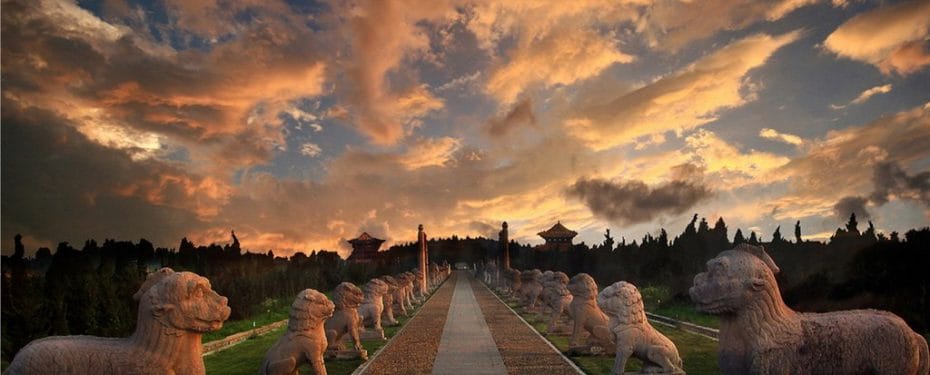Ming Tombs
Nestled in the picturesque Tianshou Mountains, just 50 kilometers (31 miles) northwest of Beijing, lies the majestic Ming Tombs, a UNESCO World Heritage Site that serves as the final resting place for 13 emperors of the Ming Dynasty (1368-1644). This remarkable complex, spanning over 120 square kilometers (46 square miles), is a testament to the architectural grandeur, cultural significance, and spiritual beliefs of one of China’s most illustrious imperial dynasties.
Table of contents
Exploring the Grandeur of the Ming Tombs
The Ming Tombs are a true marvel of ancient Chinese architecture and engineering, with each tomb meticulously designed and constructed to reflect the power, wealth, and spiritual beliefs of the Ming emperors. As you embark on this captivating tour, you’ll uncover the secrets and stories that lie within these magnificent mausoleums.
The Sacred Way (Shendao)
Your journey begins at the Sacred Way, a 7-kilometer (4.3-mile) path lined with exquisite stone carvings and statues that once served as guardians and protectors of the imperial tombs. Marvel at the intricate details of the 24 pairs of carved animals and mythical beasts, each representing different virtues and symbolizing the power and authority of the Ming Dynasty.
The Changling Tomb
The centerpiece of the Ming Tombs is the Changling Tomb, the final resting place of Emperor Yongle, the third emperor of the Ming Dynasty. This magnificent mausoleum is a true architectural masterpiece, featuring a series of intricately designed courtyards, halls, and chambers that showcase the finest examples of Ming Dynasty craftsmanship.
As you explore the Changling Tomb, you’ll be awestruck by the grandeur of the Underground Palace, a subterranean chamber that houses the emperor’s sarcophagus and was designed to replicate the splendor of an imperial palace. Marvel at the intricate carvings, vibrant frescoes, and exquisite artifacts that adorn this underground wonder.
The Dingling Tomb
Another highlight of the Ming Tombs is the Dingling Tomb, the final resting place of Emperor Wanli, the 13th emperor of the Ming Dynasty. This impressive mausoleum features a unique blend of architectural styles, combining traditional Chinese elements with influences from the West.
As you explore the Dingling Tomb, you’ll be captivated by the stunning Soul Tower, a towering structure that was believed to serve as a gateway for the emperor’s soul to ascend to the heavens. Admire the intricate carvings and decorative elements that adorn this architectural marvel, and learn about the spiritual beliefs and rituals that surrounded the burial of Ming emperors.
Immersing in the Cultural Significance of the Ming Tombs
Beyond their architectural grandeur, the Ming Tombs offer a fascinating glimpse into the cultural and spiritual beliefs of the Ming Dynasty. Throughout your tour, you’ll have the opportunity to delve deeper into the rich history and traditions that shaped this remarkable imperial era.
The Ming Dynasty Exhibition Hall
Enhance your understanding of the Ming Dynasty by visiting the Ming Dynasty Exhibition Hall, a state-of-the-art museum that showcases a wealth of artifacts, documents, and multimedia displays. Here, you’ll learn about the political, social, and cultural achievements of this illustrious dynasty, as well as the intricate rituals and beliefs surrounding imperial burials.
The Jade Carving Exhibition
Jade, a precious stone revered in Chinese culture, played a significant role in the Ming Dynasty. At the Jade Carving Exhibition, you’ll be mesmerized by the exquisite craftsmanship and artistry of jade carvings from the Ming era. Marvel at the intricate details and symbolic meanings behind these stunning works of art, which were often used in imperial rituals and ceremonies.
The Ming Dynasty Folklore and Traditions
Throughout your tour, your knowledgeable guide will regale you with fascinating tales and legends surrounding the Ming Dynasty. Learn about the spiritual beliefs, folklore, and traditions that influenced the construction and design of the imperial tombs, offering a deeper appreciation for the cultural richness of this remarkable era.
Practical Tips for Your Ming Tombs Tour
Best Time to Visit
The best time to visit the Ming Tombs is during the spring (March to May) and autumn (September to November) seasons, when the weather is mild and the surrounding landscapes are at their most picturesque. These periods also offer the opportunity to witness traditional festivals and cultural events in the region.
Getting There
The Ming Tombs are conveniently located just 50 kilometers (31 miles) northwest of Beijing, making them easily accessible by various modes of transportation. Visitors can take a guided tour, hire a private driver, or use public transportation, such as buses or the Beijing Suburban Railway, to reach the site.
Guided Tours and Audio Guides
To fully appreciate the historical and cultural significance of the Ming Tombs, it is highly recommended to join a guided tour or rent an audio guide. These resources can provide valuable insights, historical context, and expert commentary, enhancing your overall understanding and appreciation of this remarkable UNESCO World Heritage Site.
Photography and Etiquette
The Ming Tombs offer ample opportunities for photography enthusiasts to capture stunning images of the architecture, intricate carvings, and surrounding landscapes. However, it’s important to respect the cultural and historical significance of the site by following proper etiquette:
- Refrain from using flash photography inside the tombs and exhibition halls to protect the delicate artifacts and artwork.
- Dress modestly and cover your shoulders and knees when visiting the site.
- Maintain a respectful demeanor and avoid loud or disruptive behavior.
- Obtain permission before photographing local residents or staff.
The Ming Tombs are a true architectural and cultural marvel, offering visitors a captivating glimpse into the grandeur, spiritual beliefs, and artistic achievements of one of China’s most illustrious imperial dynasties. By embarking on this comprehensive tour, you’ll uncover the secrets and stories that lie within these magnificent mausoleums, creating lasting memories and a deeper appreciation for the rich heritage of ancient China.
Call: (+86) 135 7702 4672 | Email: sales@travelchinawith.me
© Copyright 2012 - 2024, TravelChinaWith.Me | Hosting by ChemiCloud





